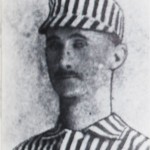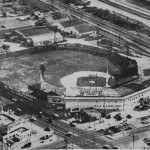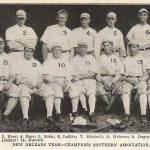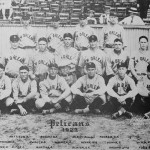 Charles Abner Powell (1860-1952), the “father” of the New Orleans Pelicans, came to New Orleans in 1887 and became a member of the city’s first professional team. As manager of the Pelicans, he invented the rain check, conceived the idea of covering the diamond with tarpaulin to prevent flooding of the field during rainstorms, and introduced Ladies Day to fans here.
Charles Abner Powell (1860-1952), the “father” of the New Orleans Pelicans, came to New Orleans in 1887 and became a member of the city’s first professional team. As manager of the Pelicans, he invented the rain check, conceived the idea of covering the diamond with tarpaulin to prevent flooding of the field during rainstorms, and introduced Ladies Day to fans here.
 Baseball had got its start in the East in the 1840s. New Orleans amateur teams started playing in the 1850s. The first local games in which the press showed an interest were played in July, 1859, on a cleared field on the Delachaise estate near today’s Louisiana Avenue by teams of a league which called itself the Louisiana Base Ball Club. By 1870, New Orleans had three baseball ,parks (one with a grandstand that could accommodate 1,200 persons) and half a dozen amateur teams. In April of that year, New Orleans saw its first professional games when the Cincinnati Red Stockings, the first entirely professional ball club, then on a national tour, played a series of five games with local amateurs including the Pelicans. The results were predictable, in favor of Cincinnati. By 1901 Abner Powell was so dissatisfied with the performance of his now professional team that he journeyed to North Carolina, bought a new one for $12,000, brought it back to New Orleans, and fired his old team. The newcomers greatly improved the Pelican’s standing. After Powell, three other remarkable Pelican managers-Charley Frank (three pennants), Johnny Dobbs (two pennants), and Larry~Gilbert (five pennants )-bossed the New Orleans teams through 1938 (with the exception of two years). These years were the brightest, the great days of New Orleans baseball-the days of Dixie Walker, Joe Martina, and Cotton Knaupp.
Baseball had got its start in the East in the 1840s. New Orleans amateur teams started playing in the 1850s. The first local games in which the press showed an interest were played in July, 1859, on a cleared field on the Delachaise estate near today’s Louisiana Avenue by teams of a league which called itself the Louisiana Base Ball Club. By 1870, New Orleans had three baseball ,parks (one with a grandstand that could accommodate 1,200 persons) and half a dozen amateur teams. In April of that year, New Orleans saw its first professional games when the Cincinnati Red Stockings, the first entirely professional ball club, then on a national tour, played a series of five games with local amateurs including the Pelicans. The results were predictable, in favor of Cincinnati. By 1901 Abner Powell was so dissatisfied with the performance of his now professional team that he journeyed to North Carolina, bought a new one for $12,000, brought it back to New Orleans, and fired his old team. The newcomers greatly improved the Pelican’s standing. After Powell, three other remarkable Pelican managers-Charley Frank (three pennants), Johnny Dobbs (two pennants), and Larry~Gilbert (five pennants )-bossed the New Orleans teams through 1938 (with the exception of two years). These years were the brightest, the great days of New Orleans baseball-the days of Dixie Walker, Joe Martina, and Cotton Knaupp.
Larry Gilbert (1891-1965), named manager in 1922. A New Orleans boy who had grown up in the ball park, Gilbert had a” meteoric rise to fame after playing with teams in Victoria, Texas, and Michigan (Battle Creek) before making the majors where he played with Milwaukee. After that he was with the Braves, a team that won the World Series in 1914. Gilbert was the first New Orleanian to play in the major leagues and the first to play in a world series. Eventually returning to his hometown and the Pelicans, Gilbert managed the team until 1938 (with the exception of 1932). When Gilbert left New Orleans, the glorious days of the Pelicans were ended. From 1939 to 1959, when the team disbanded, there were no fewer than thirteen managers and several affiliations with various major league teams and changes of ownership, but with the exception of two years when they came closer to first place, the Pelicans never won another pennant. The old magic was gone.
 “Shoeless” Joe Jackson, a rough-and-ready player, played in the Carolinas in his bare feet. He complained that the rough field made the ball “wingy,” but didn’t open his mouth to complain about his feet. Jackson played for the Pelicans and later for the Chicago White Sox. He is number 12 in the picture.
“Shoeless” Joe Jackson, a rough-and-ready player, played in the Carolinas in his bare feet. He complained that the rough field made the ball “wingy,” but didn’t open his mouth to complain about his feet. Jackson played for the Pelicans and later for the Chicago White Sox. He is number 12 in the picture.
Alexander Julius Heinemann (1876-1930), “Heine” to the fans, was largely responsible for the development of the Pelican franchise into one at the most valuable minor league properties in the country, Heine was not a ballplayer-he started in baseball by vending soft drinks in the stands, but by 1914 he was the Pelicans’s general manager, and from that time on his team began to win games and make money. It was he who moved the Pelican stadium from Carrollton and Banks to a site on Tulane and Carrollton where it bore his name until 1938. It was in Heinemann Park at one of the climactic games in the 1927 series that with 15,411 fans in the stands, a crowd of 2,000 broke down the gates and rushed in to see the game. Despite his financial success, Heine was not a favorite with the fans. He roamed the stands during a game, habitually wearing an old straw hat, and this never failed to bring calls of “cheapskate.” Plagued by financial reverses in the 1929 crash, Heinemann ended his own life in 1930.
 The pennant-winning Pelican team, 1923. This photograph was the proud possession of Cotton Knaupp, who played more than fifteen hundred games in the Southern Association and who, on August 8, 1916, made the only unassisted triple play,on record in Southern Association history.
The pennant-winning Pelican team, 1923. This photograph was the proud possession of Cotton Knaupp, who played more than fifteen hundred games in the Southern Association and who, on August 8, 1916, made the only unassisted triple play,on record in Southern Association history.
Melvin Thomas Ott from Gretna (on the west bank of New Orleans) was born in 1909. He was the greatest baseball player to come out of the New Orleans area. He began a twenty-two-year career with the New York Giants in 1926. During that span, he hit 511 home runs to set a National League record. He played in 2,730 major league games, went to bat 9,456 times, scored 1,859 runs, including 488 doubles, 72 triples, and the 511 homers. He batted in 1,860 runs and retired with a lifetime batting average of .304.
All that was left of Pelican Stadium was the mural of it painted on the wall in the Rock N Bowl facing the site where the stadium once stood. The Rock N Bowl has now changed locations. It is located at 3016 S Carrollton Ave. Not only has the Rock N Bowl carried the history of Pelican Stadium but it carries the history of the old bowling allies from the 40′s and 50′s.For more information on the Rock N Bowl New Orleans read the Hotel Monteleone review!
